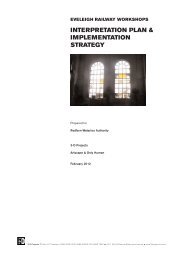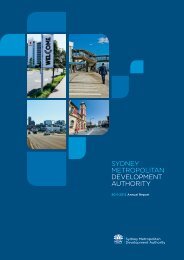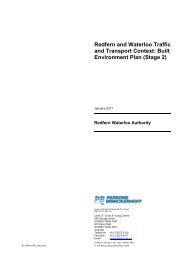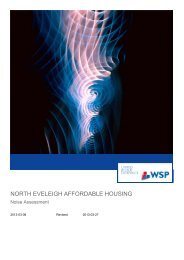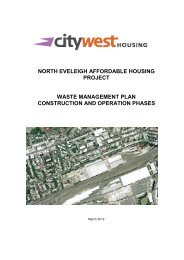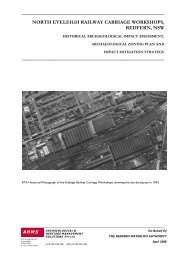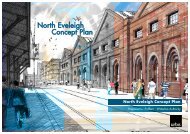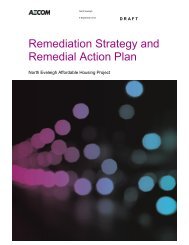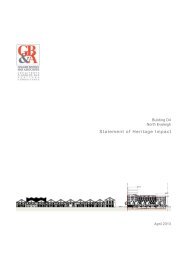Historical Archaeological Assessment - SMDA - NSW Government
Historical Archaeological Assessment - SMDA - NSW Government
Historical Archaeological Assessment - SMDA - NSW Government
You also want an ePaper? Increase the reach of your titles
YUMPU automatically turns print PDFs into web optimized ePapers that Google loves.
AECOM<br />
<strong>Historical</strong> <strong>Archaeological</strong> <strong>Assessment</strong> - The Grange - North Eveleigh Affordable<br />
Housing Project, Wilson Street, Darlington, <strong>NSW</strong><br />
6<br />
3.0 Methodology<br />
A site inspection was undertaken by Dr Susan Lampard of AECOM on the 13 June 2012. The following sections<br />
describe the methodology used.<br />
Numerous attempts were made throughout a three week period to contact the authors of the public submission to<br />
ascertain if they held further information that may provide further insight into the archaeological potential of the<br />
site. No contact could be made.<br />
3.1 Site Inspection Methodology<br />
A site inspection was undertaken over a two hour period on the morning on 13 June 2012. Dr Susan Lampard<br />
was met on site by Kerrie Symonds (Planning and Urban Renewal) and Juliet Suich (Strategic and Heritage<br />
Planner) of Sydney Metropolitan Development Authority.<br />
The objective of the field survey was to assess the water cistern identified in the public submission and the<br />
likelihood that archaeological features and/or deposits associated with The Grange Villa remained within the site.<br />
To this end, the water cistern was inspected and photographs taken.<br />
To assess the likelihood of archaeological remnants relating to The Grange Villa being preserved onsite, a<br />
walkover of the remainder of the site was undertaken. To relocate the approximate location of The Grange, the<br />
Land Title Office survey plan of 15 January 1900 (CT Vol. 1674. Folio 19, No. 11531) was oriented using Wilson,<br />
Queen and Forbes Streets as markers. Photographs of general area were taken.<br />
3.2 Significance <strong>Assessment</strong> Criteria<br />
In order to understand how development will impact on a heritage item, it is essential to understand why an item is<br />
significant. An assessment of significance is undertaken to explain why a particular site is important and to enable<br />
the appropriate site management and curtilage to be determined. Cultural significance is defined in the Australia<br />
ICOMOS Charter for the conservation of places of cultural significance (the Burra Charter) as meaning "aesthetic,<br />
historic, scientific or social value for past, present or future generations" (Article 1.1). Cultural significance may be<br />
derived from a place’s fabric, association with a person or event, or for its research potential. The significance of a<br />
place is not fixed for all time, and what is of significance to us now may change as similar items are located, more<br />
historical research is undertaken and community tastes change.<br />
The process of linking this assessment with a site's historical context has been developed through the <strong>NSW</strong><br />
Heritage Management System and is outlined in the guideline Assessing Heritage Significance (2001), part of the<br />
<strong>NSW</strong> Heritage Manual (Heritage Branch 1996). The Assessing Heritage Significance guidelines establish seven<br />
evaluation criteria (which reflect four categories of significance and whether a place is rare or representative)<br />
under which a place can be evaluated in the context of State or local historical themes. Similarly, a heritage item<br />
can be significant at a local level (i.e. to the people living in the vicinity of the item), at a State level (i.e. to all<br />
people living within <strong>NSW</strong>) or be significant to the country as a whole and be of National or Commonwealth<br />
significance.<br />
In accordance with in the guideline Assessing Heritage Significance, an item will be considered to be of State or<br />
local heritage significance if it meets one or more of the following criteria:<br />
Criterion (a) – an item is important in the course, or pattern, of <strong>NSW</strong>’s cultural or natural history (or the cultural or<br />
natural history of the local area).<br />
The site must show evidence of significant human activity or maintains or shows the continuity of historical<br />
process or activity. An item is excluded if it has been so altered that it can no longer provide evidence of<br />
association.<br />
Criterion (b) – an item has strong or special association with the life or works of a person, or group of persons, of<br />
importance in <strong>NSW</strong>’s cultural or natural history (or the cultural or natural history of the local to area).<br />
The site must show evidence of significant human occupation. An item is excluded if it has been so altered that it<br />
can no longer provide evidence of association.<br />
Criterion (c) – an item is important in demonstrating aesthetic characteristics and/or a high degree of creative or<br />
technical achievement in <strong>NSW</strong> (or the local area).<br />
24 July 2012



